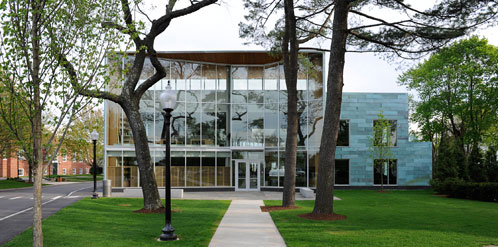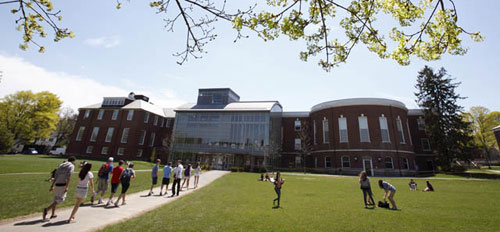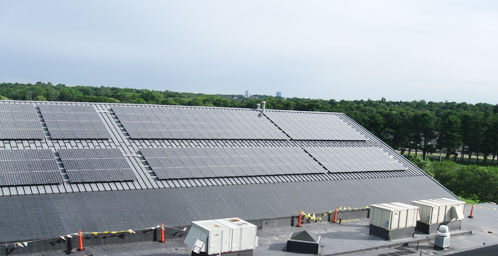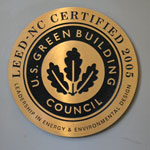“Green” Buildings
Pritzker Science Center

Milton’s new science building opened for students in the fall of 2010. William Rawn and Associates designed the building to meet silver LEED specifications.
- The building’s “Dashboard” demonstrates real-time energy usage and savings simultaneously.
- The building uses natural light extensively; sensors as well as manual controls regulate light for peak efficiency.
- Continuous filtration of roof water gathers, recharges and disperses rainwater to irrigate landscaping; a dry-grass swale is a major landscape design element framing the entrance and lining the building’s east side.
- The roof has two sections: a green roof on the overhang of the stepped, west side of the building at the base of the second floor. The top of the building uses highly-reflective TPO shingles; TPO is a chemical alloy made with recycled materials, and the shingles are 100% chemically recyclable.
- Demonstration solar hot water and photovoltaic panels produce energy for the building; we can increase their number and capacity if the technology proves effective and efficient for this building.
- Use of recycled and renewable materials is maximized throughout, and use of local materials is extensive. Green landscape design makes use of a dry-grass swale and subgrade storm water retention tank. The grasses and other native plantings in the swale thrive with the recycled rainwater, provide year-round color, and require minimal maintenance. Reused bluestone pavers are featured at the front entryway and east side gathering space; New Hampshire granite was used for curbs and benches. The landscape design features native plantings and preserved many existing trees.
Wigglesworth Hall and Schwarz Student Center

Wigglesworth Hall and the Schwarz Student Center were the first LEED-certified private preparatory school buildings in New England. Green design criteria met on this project included:
- use of existing historic buildings, reducing the need for new materials.
- utilizing recycled content material, such as drywall, carpet and cork flooring.
- installing low water consumption plumbing fixtures that feature automatic operation with occupancy sensors to prevent water waste.
- HVAC systems designed to operate at maximum energy efficiency.
Solar Panels Help Fuel the ACC

Solar panels are now a more prominent feature on the Milton campus horizon. The installation of photovoltaic solar panels is complete on the two, south facing gable roofs of the Athletic and Convocation Center (ACC). The ACC is the largest building on campus, and the largest user of electricity. Photovoltaic panels generate electrical power by converting solar radiation into direct current electricity. On a sunny, summer day, the panels will produce 900-kilowatt hours of useful electricity. This will provide about 50 percent of the electricity load for the ACC when the hockey rink is not in service. The estimated savings for Milton in electricity costs over a 20-year period is over $400,000.
Ameresco, Inc., owns the solar system on the ACC, and installed the panels. Based in Framingham, Massachusetts, Ameresco, Inc. is a leading independent provider of comprehensive energy efficiency and renewable energy solutions for facilities throughout North America.

